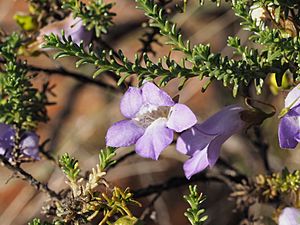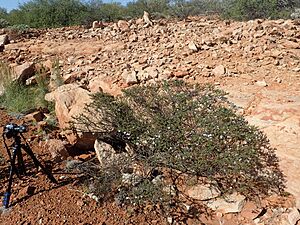Eremophila exilifolia facts for kids
Quick facts for kids Eremophila exilifolia |
|
|---|---|
 |
|
| Eremophila exilifolia leaves and flowers | |
| Scientific classification | |
| Genus: |
Eremophila (plant)
|
| Species: |
exilifolia
|
| Synonyms | |
|
Pholidia exilifolia (F.Muell.) Kraenzl. |
|
Eremophila exilifolia is a special kind of flowering plant that belongs to the figwort family. This plant is only found in Western Australia, meaning it is endemic there. It's a common shrub that looks a bit like an upside-down cone. It has small, very sticky leaves and branches, and pretty lilac-colored flowers.
Contents
What Does Eremophila exilifolia Look Like?
Eremophila exilifolia is a shrub that grows straight up and has a flat top. It usually reaches a height of about 0.3 to 1 meter (1 to 3 feet). Its leaves and branches are very sticky because they are covered in a substance called resin. This resin makes them shiny, but sometimes they can look black because of a type of mold called sooty mould that grows on the stickiness.
The leaves are also very sticky and often overlap each other, especially near the ends of the branches. They have tiny pits, which can look like dark spots. The leaves are long and narrow, or sometimes shaped like a small club. They are usually 2.5 to 12 millimeters (0.1 to 0.5 inches) long and 0.6 to 1.5 millimeters (0.02 to 0.06 inches) wide.
Flowers and Fruits
The flowers of Eremophila exilifolia grow one by one where the leaves meet the stem. Each flower sits on a sticky stalk that is about 3.3 to 15 millimeters (0.1 to 0.6 inches) long. There are five sticky green sepals, which are like small leaves that protect the flower bud. These sepals are 4 to 10 millimeters (0.2 to 0.4 inches) long and have different shapes.
The petals are 15 to 22.5 millimeters (0.6 to 0.9 inches) long and are joined together at the bottom to form a tube. The petals are usually a shade of lilac, from dark to very pale, and sometimes even white. Inside the tube, it's white with purple spots. The outside of the petal tube is covered with tiny hairs, but the inside of the petal tips is smooth. The inside of the tube is also filled with soft, woolly hairs. The four stamens, which produce pollen, are completely hidden inside the petal tube.
This plant flowers from April to October. After the flowers, it produces fruits that are broadly oval-shaped, smooth, and 4 to 7 millimeters (0.2 to 0.3 inches) long.

How Eremophila exilifolia Got Its Name
The plant Eremophila exilifolia was first officially described in 1876 by a scientist named Ferdinand von Mueller. He wrote about it in his book Fragmenta Phytographiae Australiae.
The second part of its scientific name, exilifolia, comes from two Latin words: exilis, which means "small," and folium, which means "a leaf." So, the name exilifolia refers to the plant's small leaves.
Where Eremophila exilifolia Grows
This type of eremophila is very common and can be found across the central parts of Western Australia. It often grows on rocky hills in red, stony soils. You can also find it on flat areas, mostly in a region called the Eremaean botanical province. It usually grows in mulga woodlands, which are forests with many mulga trees. In these areas, Eremophila exilifolia is often the most common shrub.
Conservation Status
The Western Australian Government's Department of Parks and Wildlife has officially stated that Eremophila exilifolia is "not threatened." This means it is not currently at risk of disappearing.
Growing Eremophila exilifolia in Gardens
The pale flowers of this eremophila look beautiful against its shiny, dark green leaves. Since it naturally grows in dry areas, it probably wouldn't do well in places with a lot of humidity or where it gets very frosty.
To grow this plant, people often use a method called grafting. This is where a piece of Eremophila exilifolia is joined onto the rootstock (the root system) of another plant called Myoporum. It grows best in soil that drains water well and in a sunny spot.


